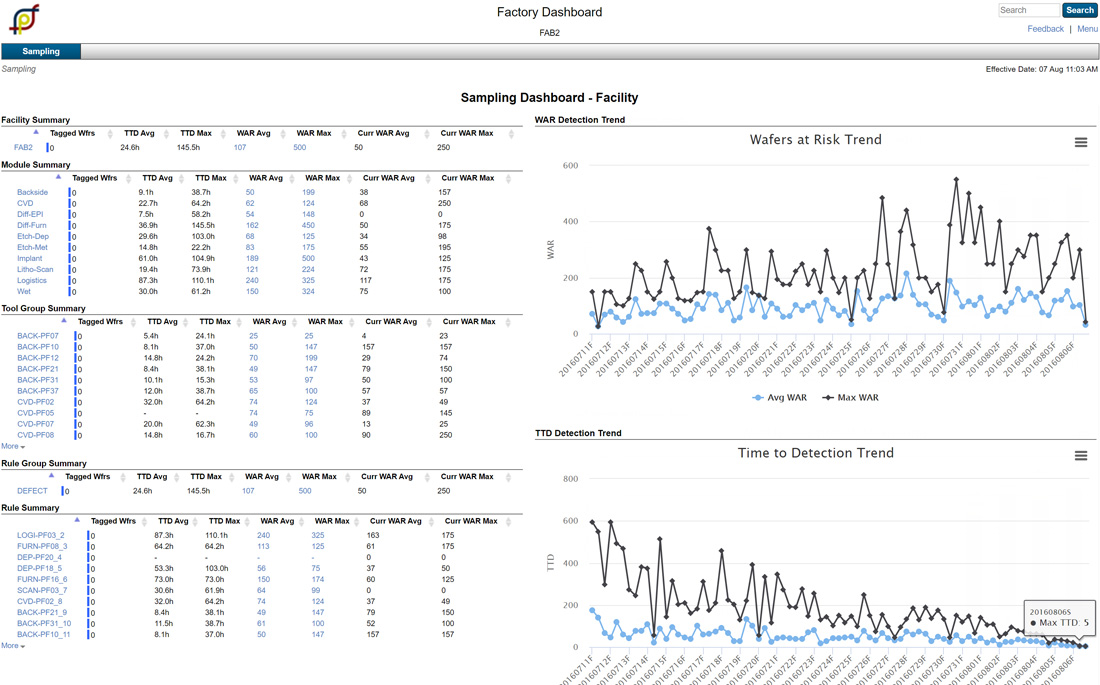September 2019
Welcome and FPS Product Introduction from John Behnke, General Manager »
Early Success with Factory Dashboard at MACOM »
Factory Scheduler for Backend Manufacturing »
Metrology Sampling Optimizer »
NextMove Metrics Track WIP Delivery Performance »
Factory Dashboard Lots Page Redesign »
A Data-Oriented Perspective on Progress Toward a Self-Driving Fab »
Metrology Sampling Optimizer
 |
 |
 |
Product Introduction and Benefit
INFICON is proud to announce our new Metrology Sampling Optimizer, available early 2020. Designed to provide the right level of defect sampling at the right time, the Metrology Sampling Optimizer minimizes the number of metrology measurements needed to ensure product quality. Products move through measurement steps faster and smarter, resulting in overall faster cycle time and optimized use of metrology tools.
Full integration with FPS Factory Dashboard provides a real time assessment of the performance of the current sampling plan (Figure 1.)

Figure 1: Sampling Dashboard showing the Wafers to Detection and Time to Detection Trend plots for the factory.
Key Features
Easy to Configure Sampling Rules
The Metrology Sampling Optimizer minimizes sampling and mitigates product risk using easy to configure sampling rules. Factory engineers can specify the action of a sampling rule using a variety of factors including setting a baseline sampling percentage that can be applied to each prior linked process tool or across process tools.
Defect Sample Minimization (No Over Sampling)
Legacy sampling systems are limited; they either apply rules in isolation or fail to adapt to important tool events. This results in over sampling of some products and under sampling of others. Increased cycle time and product risk are the consequences of these limitations.
The Metrology Sampling Optimizer protects against over sampling by improving how the sampling rules relate to one another. For example, if three sampling rules are applied to the same product, the Metrology Sampling Optimizer finds the minimum sampling plan that satisfies all three rules. The sampling plan is optimized in real time as each new measurement is recorded.
Another protection against over sampling is the creation of process linkages. Processes that are related can share the same measurement data. For example, a process link is created from Gate Photo to Gate Etch to Gate Metrology. Since the product was processed by both Photo and Etch, any defect measurement will be applied to both processes. Properly allocating measurement data reduces the chance that over sampling will occur.
Increased Risk Mitigation (No Under Sampling)
Under sampling can also be a problem when legacy sampling systems apply rules too generally. Typically, a factory would set a sampling rule that measures 30% of a particular process for defects. If a single tool ran the bulk of this process, there is a chance that all 30% of the defect measurements were selected from this tool. A second tool may not be evaluated for defects and can place product at risk. The Metrology Sampling Optimizer has an option to select 30% sampling for each tool that runs the process.
The Metrology Sampling Optimizer also allows rule generation by event. This powerful improvement sets the conditions when more sampling should be utilized. For example, a PVD tool has just completed a target change. The first five product lots following the target change should always be measured for defects. A problem tool or a new high risk technology can be assigned special rules to tailor the sampling plan to the risk level of the process.
Summary
Minimize cycle time and risk by performing the right level of defect sampling at the right time with the new FPS Metrology Sampling Optimizer.